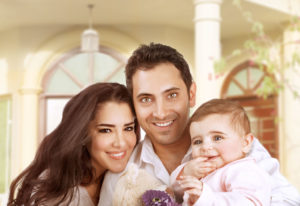We want our kids to be kids and don’t want to mollycoddle them, but we also want them to be safe. Going to other people’s houses with kids can be exhausting, but your own home should not be. You should be able to go to the bathroom without having to bundle them in with you for fear of what they can do without you, and you should be able to make dinner without fear of them scalding themselves. With the right home purchase, build or renovation – you can relax a bit and hover less as you know they can’t get into too much trouble, and allow them some freedom.
There are many gadgets to fix childproofing issues, such as socket covers, stair gates and cupboard latches, and many everyday preparations to adhere to. But here are a few basics to consider when buying a home for a young family.

Parking – If you’ve got children or friends with kids, you want good parking. Bundling groceries inside from way down the street in the rain with screaming toddlers is no fun. Also in New Zealand, a quarter of child pedestrians who end up in the hospital are run over in their own driveway. So, you want the ability for a separate area for kids to play away from cars and access to the road.
Wall secured furniture – With a country prone to shakes, you need the ability for the TV and free standing cabinets to be mounted to the wall. Several houses these days have windows everywhere, which is great for light but means TVs default to standing on a unit. Think carefully about the potential layout of the furniture and the wall fixing ability.
Closed-in outdoor area – This is the most sanity giving fixture of a house for any parent. If your kids can roam outside without you continually stressing about the road, whether it be a gated deck or fully fenced section, it will make your life so much easier.
Safety glass – Building regulations stipulate the use of Safety Glass when there are no dividing bars. But of course, this depends on the age of the home. Check whether safety glass was likely to have been used, and if not, do the sliding doors or full-length windows have a horizontal divider. If not, a temporary alternative is to add vinyl stickers at your child’s height to prevent them running into them. Another possibility is exchanging it for safety glass if it’s in a high-traffic area.
Heating – Heat pumps remove the danger that a fire or heater poses for your children, but often it’s not practical or preferable to change the heating source. If the home you’re considering has a fireplace, ensure there is a way to secure a fireguard around it. It’s all very well to say they learn because it’s so hot nearby, but accidents happen, kids trip, adults carrying kids trip – and the consequences are fierce.
Kitchen – When considering the kitchen, look at where the controls for the oven and cooktop are positioned – are they out of reach of little fingers? Also, do the counters have sharp edges? These can often be removed and replaced with rounded timber corners if that would tie in with the décor.
Window heights – If kids can climb, they can also fall out of an open window. If there are any from a substantial height, ensure they have restrictor stays, or get them added.
Window blinds – These can be wonderful in the sense you don’t get sticky fingers on them like curtains, but they do pose a strangulation risk. Check if you can alter them for a cordless version, as to replace a whole house of blinds could be costly.
Balustrades and fences – Determine if they have horizontal palings, as children can climb these and fall, or escape to the road. If the whole property is like this, it could be expensive to alter.
Pools & water courses – Pools legally must be fenced, but water courses don’t. If there is a creek nearby, you need to ensure gates are lockable and fences are unclimbable. It’s all very well to say that the children will be supervised at all times, but it only takes 30 seconds for a child to disappear from sight and get into difficulties.
Storage – Is there plenty of closed in storage, including high up? You need places available to hide or lock away those cleaning and gardening chemicals.
Poisonous plants – For your own garden, it’s easy to check for poisonous plants and replace them, but it’s not so easy with the neighbours or council planting next to your house. 10% of calls to the National Poison Centre are for children ingesting garden plants, so be mindful as everyday plants such as Arum Lily, Iris, Agapanthus and Foxglove are only a few of the everyday poisonous plants we commonly see in and around our neighbourhoods.
Open floor plan – Depending on the age of your children, an open floor plan can be a lifesaver to enable easy supervision. However, it can make it difficult to stop your children accessing dangerous items. Think about the layout, and how life will be whilst you’re cooking dinner, or trying to relax on the couch.
The health of the home – It’s all very well to think of the immediate dangers, but what about long term health? That’s a safety risk too. Is the home insulated and if not can you afford to remedy that? Is it damp and does it condensate? This can often be difficult to ascertain from just an open home, but look at the windows for surrounding timber swelling or carpet rotting. Has it got a ventilation system fitted, or can you afford to add one? They can make an overwhelming difference to the health of the home, and your ability to heat it sufficiently.
Neighbourhood – Probably the number one safety factor to consider. Nothing is ever guaranteed of course, but living in a quiet child-friendly neighbourhood can bring great peace of mind as a parent.

Obviously, many of these issues can be remedied, and compromises often have to be made, but eventually children do grow up. But ultimately your child will be happy if you’re happy, and the more you can do to save your sanity as a parent, the better.
About the Author: The above article on Child-Safe Homes was written and provided by Brent Palmer, a local leader in the field of Richmond and Nelson Real Estate sales, marketing, advanced technology for home selling, and social media.
You can contact Brent Palmer here, or at 027 544 9921. He has helped many people buy and sell homes in the Nelson, Stoke and Richmond areas for years, and would love the opportunity to help you as well.
Thinking of selling your home? I have a real passion for helping people sell their homes in our Nelson and Tasman Region, as well as the marketing, social media & advanced technology for home selling that goes along with it. I’d love to have the opportunity to sit down with you discuss how we can work together to get you the best price.
I help people buy and sell real estate in the following Nelson and Tasman towns & neighbourhoods: Wakefield, Brightwater, Hope, Appleby, Redwood Valley, Mapua, Stoke, Tahunanui, Atawhai and of course, Richmond and Nelson City.
Connect with Brent on Facebook and pretty much everywhere else.
Know someone who needs help with real estate?
Be rewarded and REFER them here.


